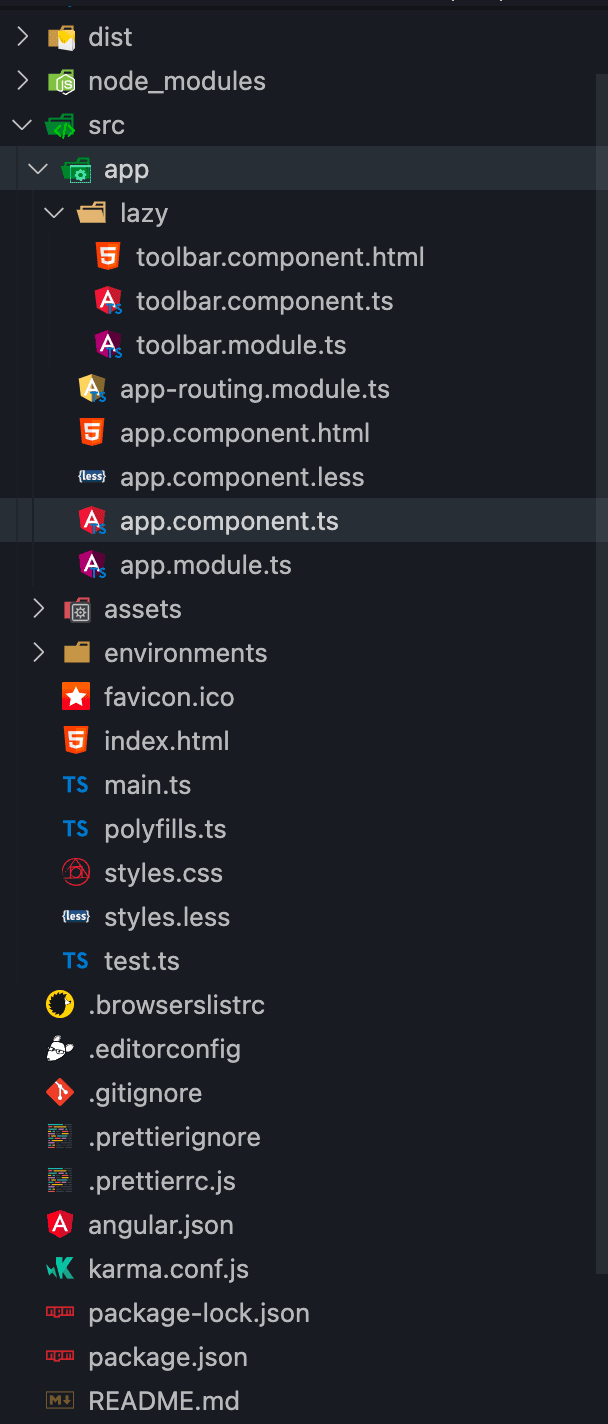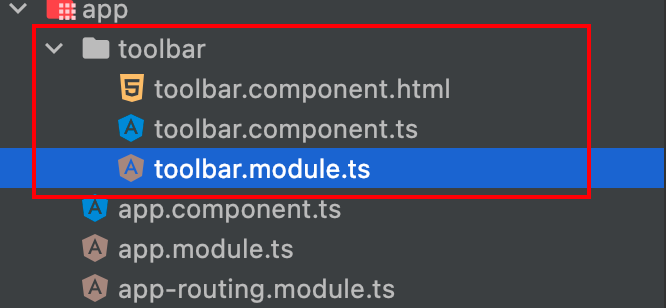这篇文章主要介绍“Angular懒加载动态怎么创建显示该模块下声明的组件”,在日常操作中,相信很多人在Angular懒加载动态怎么创建显示该模块下声明的组件问题上存在疑惑,小编查阅了各式资料,整理出简单好用的操作方法,希望对大家解答”Angular懒加载动态怎么创建显示该模块下声明的组件”的疑惑有所帮助!接下来,请跟着小编一起来学习吧!
angular中支持可以通过路由来懒加载某些页面模块已达到减少首屏尺寸, 提高首屏加载速度的目的. 但是这种通过路由的方式有时候是无法满足需求的.
比如, 点击一个按钮后显示一行工具栏, 这个工具栏组件我不希望它默认打包进main.js, 而是用户点按钮后动态把组件加载并显示出来.
那为什么要动态加载呢? 如果直接在目标页面组件引入工具栏组件, 那么工具栏组件中的代码就会被打包进目标页面组件所在的模块, 这会导致目标页面组件所在的模块生成的js体积变大; 通过动态懒加载的方式, 可以让工具栏组件只在用户点了按钮后再加载, 这样就可以达到减少首屏尺寸的目的.
为了演示, 新建一个angular项目, 然后再新建一个ToolbarModule, 项目的目录结构如图

为了达到演示的目的, 我在ToolbarModule的html模板中放了个将近1m的base64图片, 然后直接在AppModule中引用ToolbarModule, 然后执行ng build, 执行结果如图

可以看到打包尺寸到达了1.42mb, 也就是说用户每次刷新这个页面, 不管用户有没有点击显示工具栏按钮, 工具栏组件相关的内容都会被加载出来, 这造成了资源的浪费, 所以下面将ToolbarModule从AppModule的imports声明中移除, 然后在用户点击首次点击显示时懒加载工具栏组件.
首先, 新建一个ToolbarModule和ToolbarComponent, 并在ToolbarModule声明ToolbarComponent

import { NgModule } from '@angular/core';
import { CommonModule } from '@angular/common';
import { ToolbarComponent } from './toolbar.component';
@NgModule({
declarations: [ToolbarComponent],
imports: [CommonModule],
exports: [ToolbarComponent],
})
class ToolbarModule {}
export { ToolbarComponent, ToolbarModule };import { Component, OnInit } from '@angular/core';
@Component({
selector: 'toolbar',
templateUrl: './toolbar.component.html',
styles: [
`
svg {
width: 64px;
height: 64px;
}
img {
width: 64px;
height: 64px;
object-fit: cover;
}
`,
],
})
export class ToolbarComponent implements OnInit {
constructor() {}
ngOnInit(): void {}
}<div class="flex">
<svg t="1652618923451" class="icon" viewBox="0 0 1024 1024" version="1.1" xmlns="http://www.w3.org/2000/svg" p-id="2104" width="200" height="200"><path d="M412 618m-348 0a348 348 0 1 0 696 0 348 348 0 1 0-696 0Z" fill="#C9F4EB" p-id="2105"></path><path d="M673.19 393h-333a25 25 0 0 1 0-50h433a25 25 0 0 1 0 50zM600.89 235H423.11C367.91 235 323 190.28 323 135.32v-12.5a25 25 0 0 1 50 0v12.5c0 27.39 22.48 49.68 50.11 49.68h277.78c27.63 0 50.11-22.29 50.11-49.68v-16.5a25 25 0 1 1 50 0v16.5c0 54.96-44.91 99.68-100.11 99.68zM673.19 585.5h-333a25 25 0 0 1 0-50h433a25 25 0 0 1 0 50zM467 778H340a25 25 0 0 1 0-50h227a25 25 0 0 1 0 50z" fill="#087E6A" p-id="2106"></path><path d="M739.76 952H273.62a125.14 125.14 0 0 1-125-125V197a125.14 125.14 0 0 1 125-125h566.14a125.14 125.14 0 0 1 125 125v630a125.14 125.14 0 0 1-125 125zM273.62 122a75.08 75.08 0 0 0-75 75v630a75.08 75.08 0 0 0 75 75h566.14a75.08 75.08 0 0 0 75-75V197a75.08 75.08 0 0 0-75-75z" fill="#087E6A" p-id="2107"></path></svg>
<svg t="1652618941842"
class="icon"
viewBox="0 0 1024 1024"
version="1.1"
xmlns="http://www.w3.org/2000/svg"
p-id="2247"
width="200"
height="200">
<path d="M415 624m-348 0a348 348 0 1 0 696 0 348 348 0 1 0-696 0Z"
fill="#C9F4EB"
p-id="2248"></path>
<path d="M695 790H362a25 25 0 0 1 0-50h433a25 25 0 0 1 0 50zM583 649H362a25 25 0 0 1 0-50h321a25 25 0 0 1 0 50zM262 287H129a25 25 0 0 1 0-50h233a25 25 0 0 1 0 50zM262 455.33H129a25 25 0 1 1 0-50h233a25 25 0 0 1 0 50zM262 623.67H129a25 25 0 0 1 0-50h233a25 25 0 0 1 0 50zM262 792H129a25 25 0 0 1 0-50h233a25 25 0 0 1 0 50z"
fill="#087E6A"
p-id="2249"></path>
<path d="M761.76 964H295.62a125.14 125.14 0 0 1-125-125V209a125.14 125.14 0 0 1 125-125h566.14a125.14 125.14 0 0 1 125 125v630a125.14 125.14 0 0 1-125 125zM295.62 134a75.09 75.09 0 0 0-75 75v630a75.08 75.08 0 0 0 75 75h566.14a75.08 75.08 0 0 0 75-75V209a75.09 75.09 0 0 0-75-75z"
fill="#087E6A"
p-id="2250"></path>
<path d="M617 376H443a25 25 0 0 1 0-50h274a25 25 0 0 1 0 50z"
fill="#087E6A"
p-id="2251"></path>
<path d="M530 463a25 25 0 0 1-25-25V264a25 25 0 0 1 50 0v174a25 25 0 0 1-25 25z"
fill="#087E6A"
p-id="2252"></path>
</svg>
<img src="<这里应该是一张大小将近1M的base64图片, 内容较大, 就略去了...>" alt="">
</div>然后再AppComponent的中按钮点击事件处理程序中写加载工具栏模块的代码:
import { Component, createNgModuleRef, Injector, ViewChild, ViewContainerRef } from '@angular/core';
@Component({
selector: 'root',
template: `
<div class="container h-screen flex items-center flex-col w-100 justify-center">
<div class="mb-3"
[ngClass]="{ hidden: !isToolbarVisible }">
<ng-container #toolbar></ng-container>
</div>
<div>
<button (click)="toggleToolbarVisibility()"
class="bg-blue-500 hover:bg-blue-700 text-white font-bold py-2 px-4 rounded">{{ isToolbarVisible ? '隐藏' : '显示' }}</button>
<p class="mt-3">首屏内容</p>
</div>
</div>
`,
})
export class AppComponent {
title = 'ngx-lazy-load-demo';
toolbarLoaded = false;
isToolbarVisible = false;
@ViewChild('toolbar', { read: ViewContainerRef }) toolbarViewRef!: ViewContainerRef;
constructor(private _injector: Injector) {}
toggleToolbarVisibility() {
this.isToolbarVisible = !this.isToolbarVisible;
this.loadToolbarModule().then();
}
private async loadToolbarModule() {
if (this.toolbarLoaded) return;
this.toolbarLoaded = true;
const { ToolbarModule, ToolbarComponent } = await import('./toolbar/toolbar.module');
const moduleRef = createNgModuleRef(ToolbarModule, this._injector);
const { injector } = moduleRef;
const componentRef = this.toolbarViewRef.createComponent(ToolbarComponent, {
injector,
ngModuleRef: moduleRef,
});
}
}关键在于其中的第32-42行, 首先通过一个动态import导入toolbar.module.ts中的模块, 然后调用createNgModuleRef并传入当前组件的Injector作为ToolbarModule的父级Injector, 这样就实例化了ToolbarModule得到了moduleRef对象, 最后就是调用html模板中声明的<ng-container #toolbar></ng-container>的ViewContainerRef对象的createComponent方法创建ToolbarComponent组件
private async loadToolbarModule() {
if (this.toolbarLoaded) return;
this.toolbarLoaded = true;
const { ToolbarModule, ToolbarComponent } = await import('./toolbar/toolbar.module');
const moduleRef = createNgModuleRef(ToolbarModule, this._injector);
const { injector } = moduleRef;
const componentRef = this.toolbarViewRef.createComponent(ToolbarComponent, {
injector,
ngModuleRef: moduleRef,
});
}此时再来看下这番操作后执行ng build打包的尺寸大小

可以看到首屏尺寸没有开头那么离谱了, 原因是没有在AppModule和AppComponent直接导入ToolbarModule和ToolbarComponent,ToolbarModule被打进了另外的js文件中(Lazy Chunk Files), 当首次点击显示按钮时, 就会加载这个包含ToolbarModule的js文件
注意看下面的gif演示中, 首次点击显示按钮, 浏览器网络调试工具中会多出一个对src_app_toolbar_toolbar_module_ts.js文件的请求

到此,关于“Angular懒加载动态怎么创建显示该模块下声明的组件”的学习就结束了,希望能够解决大家的疑惑。理论与实践的搭配能更好的帮助大家学习,快去试试吧!若想继续学习更多相关知识,请继续关注亿速云网站,小编会继续努力为大家带来更多实用的文章!
亿速云「云服务器」,即开即用、新一代英特尔至强铂金CPU、三副本存储NVMe SSD云盘,价格低至29元/月。点击查看>>
免责声明:本站发布的内容(图片、视频和文字)以原创、转载和分享为主,文章观点不代表本网站立场,如果涉及侵权请联系站长邮箱:is@yisu.com进行举报,并提供相关证据,一经查实,将立刻删除涉嫌侵权内容。